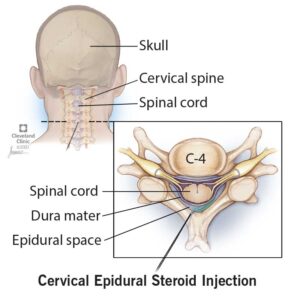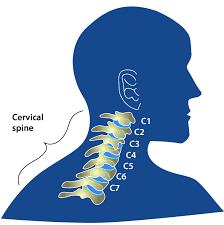Cervical Epidural Injection
What is a cervical epidural steroid injection?
 An anti-inflammatory medicine — a steroid or corticosteroid — into the epidural space around the spinal nerves in your neck. Cervical Epidural steroid injections (ESI) help manages chronic pain categorized as cervical radiculopathy. Cervical radiculopathy can radiate from your neck and shoulders down to the arms, wrists, and hands. by irritation and inflammation of the spinal nerve roots in the cervical region of your spine (neck). A variety of conditions or injuries may cause this type of chronic pain.
An anti-inflammatory medicine — a steroid or corticosteroid — into the epidural space around the spinal nerves in your neck. Cervical Epidural steroid injections (ESI) help manages chronic pain categorized as cervical radiculopathy. Cervical radiculopathy can radiate from your neck and shoulders down to the arms, wrists, and hands. by irritation and inflammation of the spinal nerve roots in the cervical region of your spine (neck). A variety of conditions or injuries may cause this type of chronic pain.
What is the cervical region of the spine?
Located in the neck region of your spinal column, the cervical region consists of seven vertebrae, each with different but important purposes. From top to bottom, the vertebrae are named C1 to C7. These vertebrae protect your brain stem and spinal cord, support your skull, and allow your head to move. C1, C2, and C3 allow you to control your forward, backward, and side head and neck movements. The specific roles for each vertebra are listed below:

- C1: this vertebra, also known as the Atlas allows you to nod your head (lateral motions).
- C2: provides sensation to the upper area of your head.
- C3: gives sensation to the side of your face and back of your head.
- C4: controls your upward shoulder motion; One of the nerves that control your diaphragm. It also provides sensation for parts of your neck, shoulder, and upper arms.
- C5: controls the deltoid muscles of your shoulders and your biceps. C5 provides sensation to the upper part of your upper arm down to your elbow.
- C6: controls the extensor muscles of your wrist; Involved in the control of your biceps. C6 provides sensation to the thumb side of your forearm and hand.
- C7: controls your triceps and wrist extensor muscles. C7 provides sensation to the back of your arm into your middle finger.
How does a cervical epidural steroid injection work?
An injection consisting of a steroid or corticosteroid medication will be inserted into the epidural space around the spinal cord in your neck by your healthcare provider. The epidural space surrounds your spinal cord like a sleeve and contains fat, the dural sac, spinal nerves, blood vessels, and connective tissue.
The steroid soothes the irritated nerve(s) and works to reduce swelling and pressure on the nerves. The steroid allows the nerve(s) time to heal. Cervical epidural steroid injections often offer temporary pain relief, but some people do not experience pain relief from the injection. The injection may provide longer relief when the procedure is followed with physical therapy.
What conditions may be treated by a cervical epidural steroid injection?
- Cervical herniated disc
- Cervical degenerative disc disease
- Cervical osteoarthritis (cervical spondylosis)
- Cervical spinal stenosis
What are the benefits of a cervical epidural steroid injection?
- reduction of swelling and inflammation
- pain reduction
- improved mobility
- postpone surgery
- decrease oral medication intake
- continue or begin physical activity
Who is a candidate for a cervical epidural steroid injection procedure?
Candidates for cervical steroid injections are usually patients that have exhausted conservative treatment options (e.g. physical therapy and medication). Typically, an MRI would be conducted and the results would indicate spinal nerve inflammation or compression. Overall, the necessity of a cervical steroid injection will be determined by your healthcare provider.
Who performs a cervical epidural steroid injection?
Cervical ESIs may be performed by:
- Physiatrists (physical medicine and rehabilitation providers).
- Radiologists.
- Anesthesiologists.
- Neurologists.
- Surgeons.
How do you prepare for a cervical epidural steroid injection procedure?
The doctor who will perform the procedure reviews your medical history and previous imaging studies to plan the best location for the injections. Be prepared to ask any questions you may have at this appointment. Patients who take aspirin or a blood thinning medication may need to stop taking it several days before the procedure. Discuss any medications with your doctors, including the one who prescribed the medication and the doctor who will perform the injection. Discuss if you are or may be pregnant due to the possible use of fluoroscopy imaging (a type of X-ray imaging) during the procedure. Do not eat or drink anything for a certain time before the cervical steroid injection procedure.
Your provider performs the procedure in an outpatient special procedure suite with access to fluoroscopy. Make arrangements to have someone drive you to and from the office or outpatient center on the day of the injection.
What happens during a cervical epidural steroid injection procedure?
A cervical ESI takes 15 to 30 minutes, followed by a recovery period.
Your provider may use one of these methods cervical epidural steroid injections transforaminal (TFESI) and interlaminar (IESI) when performing the injection.
- Interlaminar ESI: the path of the needle will travel in between two laminae in your spine to get to the epidural space. The laminae in your spine form the outer wall of the spinal canal and protect your spinal cord.
- Transforaminal ESI: the path of the needle travels through the foramina, which are openings through which nerve roots exit your spine
At the time of the procedure, you will be asked to sign consent forms, list medications you are presently taking, and if you have any allergies to medication.
Step 1: Prepare the patient
The patient changes into a medical gown and lies on an x-ray table on their belly. A local anesthetic numbs the treatment area to minimize discomfort throughout the procedure. Your healthcare provider will thoroughly clean the area of your neck where the ESI needle needs to be inserted to minimize the risk of infection. The patient remains awake and aware during the procedure to provide feedback to the physician. A low-dose sedative, such as Valium or Versed, is usually the only medication given for this procedure.
Step 2: Insert the needle
With the aid of a fluoroscope (a special X-ray), the doctor directs a hollow needle through the skin and into the region responsible for pain. Fluoroscopy allows the doctor to watch the needle in real-time on the fluoroscope monitor to ensure that the needle goes to the desired location. Contrast may be injected to confirm the correct needle location. Some discomfort occurs, but patients more commonly feel pressure than pain.
Step 3: Inject the medication
Your provider will then slowly inject the medication (usually an anti-inflammatory medication such as a steroid or corticosteroid). Some providers may inject a mixture of a corticosteroid and a local anesthetic. Next, your provider applies pressure to the injection site to prevent bleeding, cleans the area again, and applies a dressing to the site. You’ll move into a chair or bed to rest for a few minutes to an hour. This is so your provider can make sure you don’t have any reactions to the medication before you go home.
What happens after a cervical epidural steroid injection procedure?
Most patients can walk around immediately after the procedure. After being monitored for a short time, you can usually leave the office or suite. Someone must drive you home.
Patients typically resume full activity the next day. Soreness around the injection site may be relieved by using ice and taking a mild analgesic (Tylenol).
You may want to record your levels of pain during the next couple of weeks in a diary. You may notice a slight increase in pain as the numbing medicine wears off and before the corticosteroid starts to take effect.
What are the results of a cervical epidural steroid injection?
You may notice pain relief starting two to seven days after the injection. Pain may be relieved for several days to several months, allowing you to participate in physical therapy. If injections were helpful and you experience a later recurrence of pain, the procedure can be repeated. If you don’t experience any pain relief, other treatment options may be available.
What are the risks of a cervical epidural steroid injection procedure?
With few risks, cervical epidural steroid injections are considered an appropriate nonsurgical treatment for some patients. The potential risks associated with inserting the needle include bleeding, infection, allergic reaction, headache, and nerve damage (rare). Corticosteroid side effects may cause temporary weight gain, water retention, flushing (hot flashes), mood swings or insomnia, and elevated blood sugar levels in diabetics. These effects usually disappear within 7-10 days. Patients who are being treated for chronic conditions (e.g. heart disease, diabetes, rheumatoid arthritis, glaucoma, uncontrolled blood pressure) or those who cannot temporarily discontinue anti-clotting medication should consult their personal physician for a risk assessment.
If you believe you may be a good candidate for a cervical epidural steroid injection, contact us. Let Nextgen Wellness help you take the next steps in healing.
Our mission is to help patients to return to work, improve their quality of life, reduce dependence on medication and healthcare providers, and avoid persistent injuries.
Epidural Steroid Injections
Steroidal medication injected into a painful joint space can help soothe pain in arthritic joints. Injecting corticosteroids into an arthritic joint will not provide permanent relief on its own, it can dramatically reduce inflammation and pain. The effects can last anywhere between 1 week to 1 year. Injections for joint pain are usually one of the steps taken before resorting to surgery. In some patients, steroid injections can reduce pain to the point where patients are able to participate in Physical Therapy, which in turn can strengthen the surrounding muscles and eliminate the need for further treatment.
Physical Therapy
Physical therapists diagnose and treat patients with medical problems or injuries that limit their ability to take part in their daily lives. Patients will usually see a physical therapist after a referral by their primary physician. Physical therapists work with patients who have experienced an injury or disease that has affected their movement and range of motion.
At Nextgen Pain & Injury Clinic, our team of licensed physical therapists and rehabilitation experts will focus on your total health and wellness. Regardless of the cause or source of your pain, we will develop a treatment plan with your unique issues in mind.
Our treatment philosophy emphasizes evidence-based manual and therapeutic exercise techniques that are tailored toward efficiently returning patients, athletes, and employees to their pre-injury status. We treat orthopedic and sports injuries, provide spinal rehabilitation, post-surgical rehabilitation, and industrial rehabilitation. Personalized physical therapy is used to treat a variety of conditions.
- Chronic and acute medical problems
- Knee pain
- Back pain
- Leg Pain
- Ankle pain
- Sports injuries
- Musculoskeletal injuries
- Chronic medical problems
- Neurological conditions such as spinal cord injuries
Related Links & Resources
Conditions & Services
Pain Management
Auto Injury
Workplace Injury
Personal Injury
Neck & Back Injury
Knee Pain
Joint Pain
Regenerative Medicine
Physical Therapy
Aquatic Therapy
Vestibular Rehab
Traumatic Brain Injury
We’re Always Just Around the Corner.
Our clinics are conveniently located to provide care for the DFW area.
Arlington, TX
801 Road to Six Flags West, Suite 146
Arlington, TX 76012
Click to Call Arlington Office


